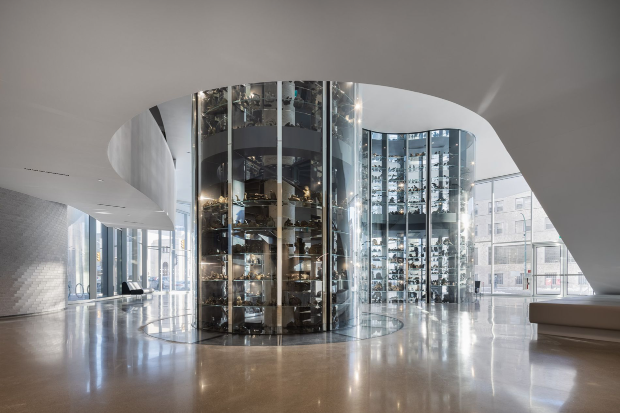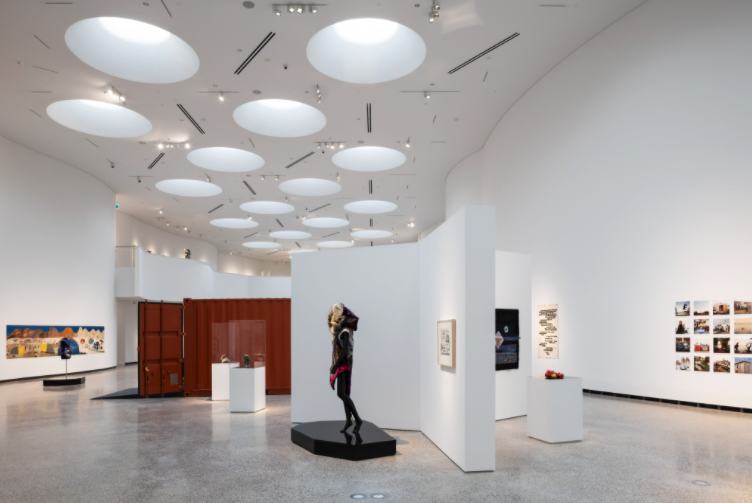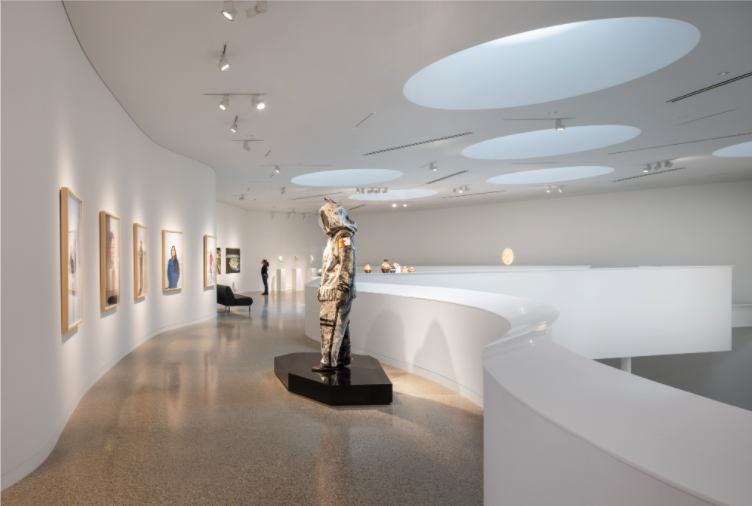Qaumajuq: Winnipeg Art Gallery’s new WOW Factor!
WOW! That one word captures my reaction to the virtual tour of the Winnipeg Art Gallery’s (WAG) new Qaumajuq Gallery and its inaugural exhibition, INUA.
I was impressed not only by the design of the building but also how it complements the architecture of the existing iconic (circa 1972) WAG building in subtle and synergistic ways. I loved the striking 3-storey tubular “visible vault” that allows visitors to walk around and see 4,500 carvings that otherwise would be hidden away in storage rooms. I also loved the 22 skylights that allow natural light down into and throughout the building.
The name Qaumajuq, gifted to the building by a circle of language keepers and Elders, “it is bright, it is lit.” I love message of positivity and enlightenment. I love how the architect and curators have worked together, in consultation with the Inuit community to create an appropriate space to showcase both traditional and contemporary Inuit Art.
Link: Indigenous Naming
I can’t wait to visit the building and the exhibition in person as soon as possible. It opens to the public March 27, 2021.
Backstory: I been a big fan of the WAG ever since I lived just a few blocks away back in 1976/77. It was the first really contemporary iconic building that I fell in love with. At the time, I was a student but also a budding Inuit art collector having acquired several prints and sculptures. I can look up from my desk right now and see three Inuit sculptures I bought in Winnipeg.
The visible storage vault allows visitors to see 1,000s of small Inuit carvings and artifacts.
The Building
Los Angeles-based architect, Michael Maltzan gave a brief explanation of how the design of the building was inspired by a trip to the North where he and the indigenous team of advisors were able to experience the extreme bright light and space.
I loved this image from Maltzan’s presentation of the various shapes that were considered for the building.
Working collaboratively with a team of indigenous advisors, he created a design that he believes respects the Inuit’s unique landscape and sense of place.
The building definitely fits into the current theme of contemporary architecture where the building itself is a work of art, in this case a piece of stone sculpture.
The smooth, wavy, white granite façade has similarities to the curves of an Inuit soapstone sculpture, or perhaps the soft mounds of snowdrifts.
The interplay of light and shadow reference the same qualities of light, reflection and refraction of light and shadow of snow. Maltzan noted the light in Winnipeg is very similar to that of the Arctic.
Qaumajuq Gallery at night. (Photo credit: Lindsay Reid)
At night, the building’s façade lights up and has a glow that emulates the Northern Lights.
It will be used for projections of art and other imagery, accompanied by music in a 20-minute loop on the building’s exterior at the corner of Memorial Blvd and St. Mary Ave.
The light shows will look best in the winter when it gets dark early (but too cold to stand there for 20 minutes for many people).
Summer viewing will be more pleasurable, though it doesn’t get dark until 10 pm.
The building’s stark white interior appears to create a spiritual sense of place that is perfect for exhibiting Inuit art. Maltzan’s design successfully flows vertically within the new building while also connecting with the existing building old one – no easy feat.
The new building’s delicate curved façade, contrasts in a synergistic way with the angular thrust of the wedge-shaped 1972 building by Da Rosa. Together they make an eye-catching statement about Winnipeg’s growing contemporary design sensibility.
Link: Architectural Digest: Why Design Lovers Should Visit Winnipeg.
Backstory: The Winnipeg Art Gallery is one of Canada’s oldest public art galleries. The main building, designed by Gustavo Da Roza opened in 1972. Utilizing the triangular site across the street from the historic Hudson’s Bay building (now closed), Da Roza created a limestone wedge that looked a bit like an iceberg or perhaps an ice-breaker ship. It was a bold design.
Winnipeg Art Gallery’s main building designed by Gustavo Da Roza opened in 1972. (photo credit: Tourism Winnipeg).
Winnipeg Art Gallery today with the main building and new Qaumaajuq Gallery. (Photo Credit: Lindsay Reid)
Corner of Memorial Blvd and St. Mary Ave. (photo credit: Lindsay Reid)
Intersection of the old and new building. (photo credit Lindsay Reid)
The Exhibition: INUA
INUA, meaning “life force” in many dialects across the Arctic - is an acronym for Inuit Nunangat Ungammuaktut Atautikkut, or “Inuit moving forward together,” reflecting the curators’ collective vision for Qaumajuq, the Inuit art centre.
The exhibition includes everything from traditional dolls, purses and wall hangings to drone photographs, from mid-career and senior artists, from Canada and across the northern circumference of the planet. I love that the exhibition connects the past, the present and points to the future of Inuit art within a contemporary context.
I like the fact the main exhibition space is spacious, allowing the curatorial team lead by independent curator Dr. Heather Igloliorte - to showcase the diversity of Inuit art being produced today. The exhibition includes not only artists from Canada’s north, but from Alaska and Greenland, as well as Inuit artists living across Canada. The exhibition offers a glimpse into how Inuit art has evolved - while still respecting and integrating traditional materials and techniques - by contemporary artists who have gone to art schools around the world.
The exhibition features 90 artists and 100 artworks (including 10 new artworks commissioned for the exhibition). It is a collaborative effort of an all-Inuit team representing the four regions of Inuit Nunangat, the Inuit territories of Canada.
Dr. Heather Igloliorte (Happy Valley-Goose Bay), Special Advisor to the Provost, Advancing Indigenous Knowledges; University Research Chair, Circumpolar Indigenous Arts; Associate Professor, Department of Art History, Concordia University; and Co-Chair of the WAG Indigenous Advisory Circle
Krista Ulujuk Zawadski (Igluligaarjuk/Chesterfield Inlet), Curator of Inuit Art for the Government of Nunavut; Multidisciplinary PhD candidate; Inuit Tapiriit Kanatami Inuit Cultural Repatriation Award Recipient
Kablusiak (Somba K’e/Yellowknife), Sobey Art Award shortlisted multidisciplinary Inuvialuk artist
Asinnajaq (Inukjuak), Curatorial team member for Canada’s Pavilion at the 2019 Venice Biennale; multidisciplinary artist
Link: Winnipeg Art Gallery Website
Photos below: Qilak, Main Inuit Gallery, Qaumajuq, the Inuit art Centre at the Winnipeg Art Gallery. Photo by Lindsay Reid
William Noah. Inuit (Baker Lake), 1943–2020. The Skeletoned Caribou, 1974. Coloured Pencil on paper. Collection of the Winnipeg Art Gallery. Acquired through a grant from Hudson's Bay Oil and Gas Company Limited, G-80-247
Pudlo Pudlat. Inuit (Kinngait), 1916–1992. Women At the Fish Lakes, 1977. lithograph on paper, 41/75. Government of Nunavut Fine Art Collection. On long-term loan to the Winnipeg Art Gallery, 984.13.7
Maureen Gruben. Inuvialuit (b. 1963 Tuktuyaaqtuuq). Waiting for the Shaman, 2017. Bones from polar bear paws and resin. 55.9 × 55.9 × 2.5 cm. Photo: Kyra Kordowski.
Annie Manning. Inuit (Kinngait), b. 1943. Necklace, 1976. brass, stone (soapstone), ivory. Government of Nunavut Fine Art Collection. On long-term loan to the Winnipeg Art Gallery, 2.77.21
Jesse Tungilik’s sealskin and beads spacesuit (2019), a collection of Crown-Indigenous Relations and Northern Affairs Canada Indigenous Art Centre. (credit: Jessica Kotierk, Winnipeg Art Gallery)
Photo by Labrador photographer Eldred Allen, who stitches together multiple drone photos to create digitally altered landscapes. (credit: Winnipeg Art Gallery)
Last Word
I couldn’t help but notice the media’s questions at the end of the tour all seemed to focus on trying to find fault with the building and/or the exhibition. Probing to see if there was an Inuit architect involved…asking if it was appropriate to exhibit artwork made in the North in a southern city…and enquiring about how the Inuit were involved in the planning and execution of the exhibition.
These questions were well-answered to my satisfaction during the presentation. All of the speakers acknowledged how the process from conception (in 2012) to completion (in 2021) was done with continual consultation, collaboration and cooperation with Inuit and other indigenous people.
Qaumajuq is all about being transparent and inclusive. Kudos to all involved in what looks like a thoughtful and meaningful addition to Canada’s and Winnipeg’s cultural scene. It is a wonderful reminder that the Arctic is an important and valued part of Canada.
FYI: The cost of the 36,000 square foot new building and 16,000 square foot renovation was $65 million. It included not only the gallery and storage space, but an 85-seat multi-purpose theatre, new cafe, expanded Gallery Shop and seven new studios.
Tourist Tip: WAG’s gallery shop is a hidden gem. If you are looking for something special to take home from Winnipeg it is the place to shop.
If you like this blog, you will like these links:
Canadian Human Rights Museum: Money Well Spent?

















